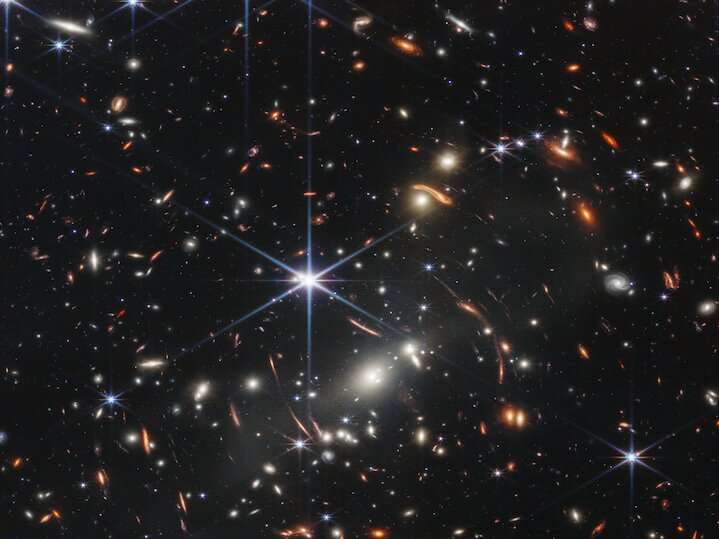Astrophysicists break down the impact of newly released NASA images

The first images from NASA’s new space telescope unveiled this week include a new look at the universe, expanding our view of the galaxy as we know it. The images include a high resolution “window” to millions of stars through the Milky Way’s dust, a new look at galaxies lightyears away for the first time in 30 years. LSU Astrophysicists share their reactions to the photos and how the Webb telescope impacts future research and discovery.
What is the significance of these photos?
“These images are the first scientific results from Webb, a successor to Hubble, representing the product of two decades of work from scientists at NASA, ESA, and CSA. Each of the five in the initial release come from only the first week of observations. Not only are they breathtaking, they are harbingers for the results Webb will enable over the next decade,” says LSU Astrophysicist Eric Burns.
Does this change the way scientists look at space? What does it mean for the world of science?
“The infrared light that Webb sees will enable us to study the first galaxies, the atmospheres of planets in our solar system and in other solar systems, and understand how stars are formed and evolve. It will revolutionize our understanding of many topics in astrophysics from the evolution of the universe to the forging of the elements. Webb’s capabilities will also reveal unknown and unexpected findings which will take years to understand,” says Burns.
“Webb enables so much new science that it’s hard to know where to begin. Studying the ultraviolet light from the first galaxies is what it was designed to do, but its high-resolution images of millions of stars through the Milky Way’s dust, and its spectroscopic studies of molecules in the atmospheres of exoplanets are what excites me most,” says LSU Professor of Physics and Astronomy Matthew Penny.
What do these photos mean to the average person?
“Hubble has stood alone as the greatest instrument for scientific engagement with the public. Its images led to a generation of STEM individuals who continue their critical role in advancing and improving society as a whole. The scientific results of Hubble helped us to understand our place in the universe, how we got here, and where we are going. Webb is the successor. Scientifically it will pick up where Hubble, and other telescopes have brought us, and its images and scientific breakthroughs will continue to inspire current and future scientists, engineers, and educators,” says Burns.
“Astronomy, the stars, planets and galaxies are perhaps second only to the heart as a cultural link to the world of science and has been likely been so since humans gained consciousness. The topic interests nearly everyone, and its images, and references to it, are scattered throughout every form of human cultural expression: literature, music, theater & film, and painting, photography & ceramics. This new observatory provides us with a new way to view the universe with high-resolution, colorful, infrared images, and upon every image it stamps its signature six-spike star. Not only that, it will enable scientists to answer fundamental questions about our universe and how it evolved to be hospitable to our existence, and of course, raise a whole host of new questions for the next generations of scientists to answer,” says Penny
In your opinion, what is the most interesting thing about the photos?
“My area of research focuses on gamma-rays and gravitational waves, so I get to enjoy these releases more like a member of the public. What struck me most was the comparison of the images from Webb and Hubble of the lensing from SMACS 0723. The angular resolution of the telescopes is pretty close, but the change in wavelength and collection area resulted in a huge improvement. When I dug up the Hubble photo last night, the comparison just blew me away,” says Burns.
Could this be the first step toward finding life in space?
“When Webb was first imagined we had never seen an exoplanet, and when construction began the study of exoplanets was in its infancy. Now that it has launched there are more than 5,000 known exoplanets. Webb will be able to study the atmospheres of some of these planets, determining their chemical makeup and even find evidence for clouds, like on Earth. It will certainly revolutionize our understanding of the types of planets that can exist, with targets from Kepler and TESS, but my personal opinion is that we would need to be pretty lucky for Webb to prove the existence of alien life—though many, better-informed scientists disagree with me,” says Burns.
“Webb has demonstrated success of numerous technologies that would be used for that future telescope, and has placed us on a path to understanding, ‘Are we alone?’ in my lifetime.”
NASA releases James Webb telescope ‘teaser’ picture
Citation:
Astrophysicists break down the impact of newly released NASA images (2022, July 15)
retrieved 15 July 2022
from https://phys.org/news/2022-07-astrophysicists-impact-newly-nasa-images.html
This document is subject to copyright. Apart from any fair dealing for the purpose of private study or research, no
part may be reproduced without the written permission. The content is provided for information purposes only.
For all the latest Science News Click Here
For the latest news and updates, follow us on Google News.

